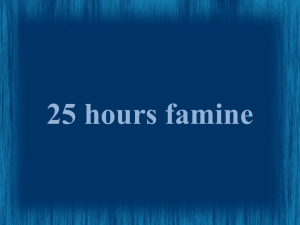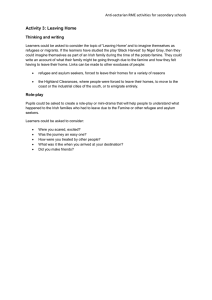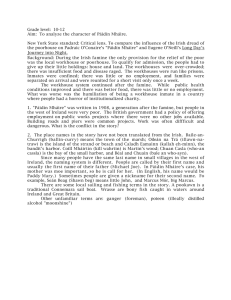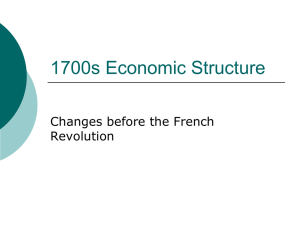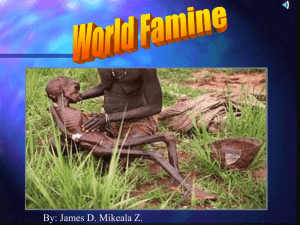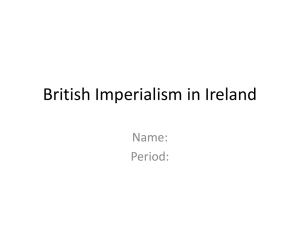TOPIC VII: The Amazing Potato and the History of Ireland
advertisement
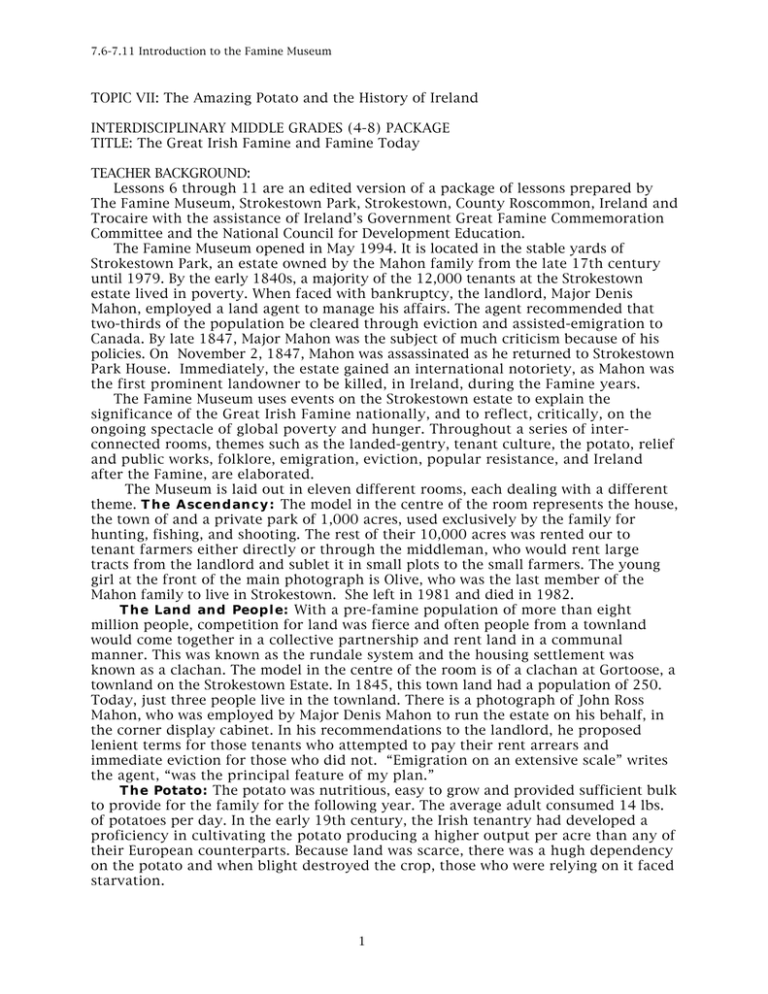
7.6-7.11 Introduction to the Famine Museum TOPIC VII: The Amazing Potato and the History of Ireland INTERDISCIPLINARY MIDDLE GRADES (4-8) PACKAGE TITLE: The Great Irish Famine and Famine Today TEACHER BACKGROUND: Lessons 6 through 11 are an edited version of a package of lessons prepared by The Famine Museum, Strokestown Park, Strokestown, County Roscommon, Ireland and Trocaire with the assistance of Ireland’s Government Great Famine Commemoration Committee and the National Council for Development Education. The Famine Museum opened in May 1994. It is located in the stable yards of Strokestown Park, an estate owned by the Mahon family from the late 17th century until 1979. By the early 1840s, a majority of the 12,000 tenants at the Strokestown estate lived in poverty. When faced with bankruptcy, the landlord, Major Denis Mahon, employed a land agent to manage his affairs. The agent recommended that two-thirds of the population be cleared through eviction and assisted-emigration to Canada. By late 1847, Major Mahon was the subject of much criticism because of his policies. On November 2, 1847, Mahon was assassinated as he returned to Strokestown Park House. Immediately, the estate gained an international notoriety, as Mahon was the first prominent landowner to be killed, in Ireland, during the Famine years. The Famine Museum uses events on the Strokestown estate to explain the significance of the Great Irish Famine nationally, and to reflect, critically, on the ongoing spectacle of global poverty and hunger. Throughout a series of interconnected rooms, themes such as the landed-gentry, tenant culture, the potato, relief and public works, folklore, emigration, eviction, popular resistance, and Ireland after the Famine, are elaborated. The Museum is laid out in eleven different rooms, each dealing with a different theme. The Ascendancy: The model in the centre of the room represents the house, the town of and a private park of 1,000 acres, used exclusively by the family for hunting, fishing, and shooting. The rest of their 10,000 acres was rented our to tenant farmers either directly or through the middleman, who would rent large tracts from the landlord and sublet it in small plots to the small farmers. The young girl at the front of the main photograph is Olive, who was the last member of the Mahon family to live in Strokestown. She left in 1981 and died in 1982. The Land and People: With a pre-famine population of more than eight million people, competition for land was fierce and often people from a townland would come together in a collective partnership and rent land in a communal manner. This was known as the rundale system and the housing settlement was known as a clachan. The model in the centre of the room is of a clachan at Gortoose, a townland on the Strokestown Estate. In 1845, this town land had a population of 250. Today, just three people live in the townland. There is a photograph of John Ross Mahon, who was employed by Major Denis Mahon to run the estate on his behalf, in the corner display cabinet. In his recommendations to the landlord, he proposed lenient terms for those tenants who attempted to pay their rent arrears and immediate eviction for those who did not. “Emigration on an extensive scale” writes the agent, “was the principal feature of my plan.” The Potato: The potato was nutritious, easy to grow and provided sufficient bulk to provide for the family for the following year. The average adult consumed 14 lbs. of potatoes per day. In the early 19th century, the Irish tenantry had developed a proficiency in cultivating the potato producing a higher output per acre than any of their European counterparts. Because land was scarce, there was a hugh dependency on the potato and when blight destroyed the crop, those who were relying on it faced starvation. 1 7.6-7.11 Introduction to the Famine Museum Poor Law and Relief: The political policies prevailing at the time of the famine are detailed on the plates covering the top of the workhouse bench (from the Roscommon Workhouse). Strokestown to Lanesboro as part of a relief works scheme and the other is a letter written on behalf of the tenants from Cloonahee townland, who are pleading with the landlord to be given employment on the relief scheme so that they can provide for their families. This document captures the desperation of a people faced with starvation. Disease: A video covers the conditions that prevailed in the workhouses in the area at the time of The Famine. There is footage of the House interior and the surrounding countryside. Emigration: The landowners were made responsible for providing for the destitute in their own areas and it was cheaper to send them on an assisted emigration than to pay for their upkeep in the workhouse. Note the letter from the Kilbeg Tenants to Guinness and Mahon and the emigration listing for the Maguire family, Gortoose. Major Mahon sent 1,000 tenants to Canada on three ships, almost half of them died on the voyage due to a combination of their weakened state and the unsanitary conditions of the ships. Eviction: The evictions continued mercilessly on the estate at Strokestown, the panels in this room relate to the makeshift scalpeens that the evicted families would erect, and also to the efforts made by the Bishop of Elphinn at that time to publicise the conditions prevailing on the Strokestown Estate. Secret Societies: While most people were in no fit condition to fight against the injustices, there was a growth in the activities of secret societies during the famine. In 1847, Major Mahon was shot dead because of his emigration and eviction schemes. The gun on display is believed to be the one used to shoot the Major. Two men were hanged for the killing and the alleged confession of one of them, Patrick Hasty, is on display. The panels gave different accounts of the killing and through the headphones you can listen to an interview between Luke Dodd and John Lally, where Mr. Lally gives his account of what he heard about the shooting of Major Mahon. The Aftermath: The famine completely wiped out the poorest social class, the landless labourer. The language declined, emigration became a way of life, and people strove to completely erase from their minds all memories of the most catastrophic event in Ireland’s past. Contemporary Famine: The last room in the Famine Museum is dedicated to contemporary famine. The various artefacts on display come from Somalia and serve to highlight the fact that the materials used throughout the developing world today are so similar to what were used in Ireland 150 years ago. all of these items are of a perishable nature and will rot away over time, if left at the mercy of the elements. We intend to continually update the displays in this room to reflect current issues in the developing world. The emphasis here is that all these diseases are now curable, but are still responsible for a huge number of deaths in the developing world. Trocaire was set up by the Bishops of Ireland in 1973 to respond to the needs of the people of the developing world. Their vision recognized the need not only to support people at local level in Africa, Asia and Latin America but also to take action at home. In the developing world, through supporting programs at community level Trocaire tackles the root causes of poverty and injustice. In Ireland, through awareness raising and education programs, Trocaire promotes a greater understanding of the issues affecting the people around the world and works to address the causes of the problems. Central to Trcaire’s work is a focus on human rights. Emergency relief has been provided to famine victims in Somalia, Ethiopia, Sudan and Liberia responding to people’s basic right to food, water and shelter. Trocaire’s main goal is to provide ongoing support to local people so that they can build up their communities and 2 7.6-7.11 Introduction to the Famine Museum improve the conditions in which they live. These projects include agricultural training, adult education, health care and income generation schemes. They help people to obtain their basic human rights such as the right to a decent standard of living, the right to work and the right to health. Projects such as these also help to make people less vulnerable in times of crises, and so prevent future emergencies. The partnership between Trocaire and the Famine Museum provides an opportunity to examine the injustices which exist in famine-affected countries today, to develop an understanding of the diverse causes of famine and to look at the variety of responses. The Great Irish Famine provides a unique opportunity to provide a link between the past and the present and between the experience of Irish people and the experience of famine victims in the world today. It also provides an opportunity to challenge historical and contemporary stereotypical images and to gain an insight into what life is like for people affected by famine. “The Great Irish Famine and Famine Today” activity based education pack was prepared by Luke Dodd, Sheila Dillion, and Triona Sherwin. It includes activities that help students explore multiple perspectives on events through role-play and historical reenactments. Students also learn to act as historians and gather information from primary source material and to act as citizens who must analyze contemporary problems and recommend policy choices. For example, students examine the life of a family in Somalia, explore the causes of famine today, discuss possible responses to famine today, and identify the similarities and differences between the Great Irish Famine and famine today. The first section (AIMS 6 and 7) involves a role play based on the 1840s Famine experience on the Strokestown estate. It is important that students see how history is not a simple definitive story, but rather a multi-faceted and complex series of issues dependant on the people involved. By becoming embroiled in debates, the students gain empathy for the characters, bringing into question the ideas of objectivity and bias. The second section (AIM 8) involves group discussion based on the critical analysis of images of famine, both historical and contemporary. Images were picked to initiate debates about themes such as racism, stereotyping, the portrayal of famine, and the representation of the poor. Section three (AIMS 9, 10, and 11) presents a case study of Somalia setting students the task of comparing Ireland of the 1840s with that of 20th century Somalia. The sections are structured so that each has an introduction, central activities and debriefing exercises. PROJECTS: - Studentsd should collect articles and pictures from newspapers and magazines on events in underdeveloped or third world countries. In an essay, discuss the way the choice of images influences the way people understand the events discussed in the articles. - Students should research and write reports about the role of the United Nations, the United States government and non-governmental organizations in providing international relief. - Students should organize a campaign to support an international relief effort. REFLECTION: A number of classes that field tested the Great Irish Famine curriculum guide participated in a Famine Museum. Students used material from this package to create their own exhibits about the Great Irish Famine and about the problems of faminie and homelessness today. 3

